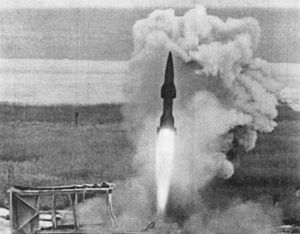Wasserfall
| Wasserfall | |
|---|---|
 |
|
| Type | Surface-to-air missile |
| Production history | |
| Manufacturer | Flak-Versuchskommando Nord, EMW Peenemünde |
| Unit cost | 7,000–10,000 Reichsmark |
| Produced | March 1943 |
| Specifications | |
| Weight | 3,700 kilograms (8,200 lb) |
| Length | 7.85 metres (25.8 ft) |
| Diameter | 2.51 metres (8 ft 3 in) |
| Warhead | 235 kilograms (518 lb) |
|
Detonation
mechanism |
Proximity |
|
|
|
| Engine | liquid-fueled rocket motor |
|
Operational
range |
25 kilometres (16 mi) |
| Speed | 770 metres per second (1,700 mph) |
|
Guidance
system |
MCLOS (Manual Command to Line Of Sight); operator used a radio command link to steer the missile along the optical line of sight from launch point to target. |
|
Launch
platform |
Fixed. |
The Wasserfall Ferngelenkte FlaRakete (Waterfall Remote-Controlled A-A Rocket), was a German guided surface-to-air missile project of World War II. The Wasserfall required considerable development work, which was not completed before the end of the war.
Wasserfall was essentially an anti-aircraft development of the V-2 rocket, sharing the same general layout and shaping. Since the missile had to fly only to the altitudes of the attacking bombers, and needed a far smaller warhead to destroy these, it could be much smaller than the V-2, about 1/4 the size. The Wasserfall design also included an additional set of fins located at the middle of the fuselage to provide extra maneuvering capability.
Unlike the V-2, Wasserfall was designed to stand ready for periods of up to a month and fire on command, therefore the volatile liquid oxygen used in the V-2 was inappropriate. A new engine design, developed by Dr. Walter Thiel, was based on Visol (vinyl isobutyl ether) and SV-Stoff, or 'red fuming nitric acid' (RFNA), (94% nitric acid, 6% dinitrogen tetroxide). This hypergolic mixture was forced into the combustion chamber by pressurizing the fuel tanks with nitrogen gas released from another tank. Wasserfall was to be launched from rocket bases (code-named Vesuvius) that could tolerate leaked hypergolic fuels in the event of a launch problem.
Guidance was to be a simple radio control manual command to line of sight (MCLOS) system for use against daytime targets, but night-time use was considerably more complex because neither the target nor the missile would be easily visible. For this role a new system known as Rheinland was under development. Rheinland used a radar unit for tracking the target and a transponder in the missile for locating it in flight, read by a radio direction finder on the ground. A simple analog computer guided the missile into the tracking radar beam as soon as possible after launch, using the transponder to locate it, at which point the operator could see both "blips" on a single display, and guide the missile onto the target as during the day. Steering during the launch phase was accomplished by four graphite rudders placed in the exhaust stream of the combustion chamber, and (once high airspeeds had been attained) by the four air rudders mounted on the rocket tail. Commands were sent to the missile using a modified version of the "Kehl-Strassburg" (code name Burgund) joy-stick system used to direct Henschel Hs 293 glide bomb, which had some significant successes against allied ships in the Mediterranean.
...
Wikipedia
